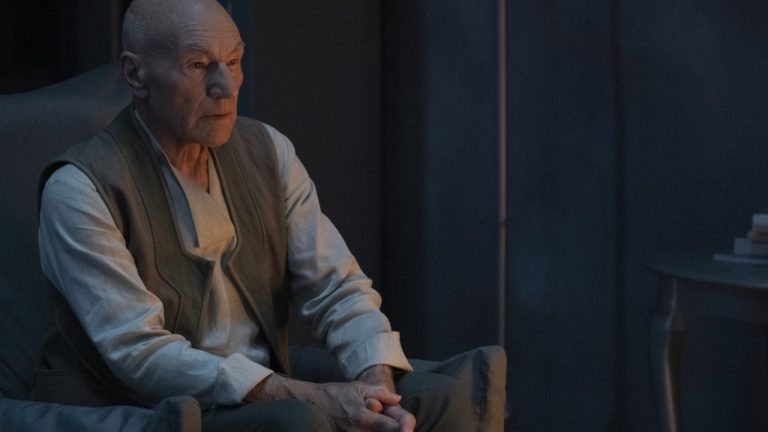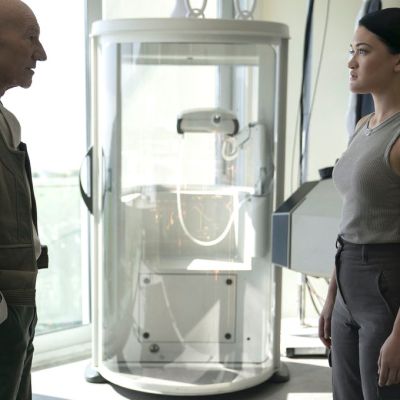Star Trek: Picard Episode 10 Easter Eggs and References
From a mystery vocal cameo, to Star Trek’s deep, deep past, here’s everything you might have missed in the big finale.

Warning: This Star Trek: Picard review contains MAJOR spoilers for the season finale.
Long live Jean-Luc Picard!
In the final episode of Star Trek: Picard Season 1, “Et in Arcadia Ego, Part 2,” the newest Trek series not only changes the nature of a few very beloved characters, it also manages to reference the entire history of Star Trek along the way.
But there’s more! In addition to shout-outs to a very famous spaceship maneuver, the finer points of intergalactic treaty, and an eyebrow-raising reference to prehistoric Star Trek times, this episode also contained a hidden vocal cameo! Read on to find out everything you didn’t know about the Season 1 finale of Star Trek: Picard…
Vulcan prehistory
When Narek tells a scary campfire story about the end of the world, he mentions that this myth might “date back to long before our ancestors first arrived on Vulcan.” Cue record-stopping sound. WHAT. Did Narek just say that Romulans and Vulcans did not originate on Vulcan? Hold-up. Since when?
Well, as any good Trek fan knows, the Romulans left the planet Vulcan after the time of Surak. Basically, the Romulans didn’t want to be logical and unemotional, and started their own, non-Vulcan Empire. But, if that were true, then shouldn’t Narek have said that the myth “dates back to when Romulans still lived on Vulcan?” Actually, no. In the TOS episode, “Return to Tomorrow,” the alien Sargon (glowing round ball) claims that he and his kind actually seeded the galaxy like a gillion years prior. Kirk dismisses this because it runs counter to evolution, but Spock says that this idea explains certain things about Vulcan prehistory, implying that Vulcans (and by extension, Romulans) might not have originated on the plaent Vulcan.
Later, in TNG episode, “The Chase,” it’s pretty well established that some ancient humanoid race seeded several planets in the Star Trek galaxy. Finally, in the TNG episode, “Who Watches the Watchers,” it’s made very clear that other proto-Vulcans exist on totally unrelated planets, which makes the idea of Vulcans arriving from other planets, totally plausible.
In other words, Narek’s got his history (mostly) correct.
Seven’s assimilation
When Narissa fights Seven of Nine in the crashed Borg Cube, she mocks her, saying, “Poor Queen Annika, all she got for her sixth birthday was assimilated.” This references the Star Trek: Voyager episode“The Raven,” in which Seven learns the details of her assimilation.
Picard maneuver
While trying to hold off the Romulan fleet, Dr. Jurati mentions “the Picard maneuver,” and points out “that’s an actual thing—you made it look like the Enterprise was in two places at once.” Rightly, Picard corrects her, saying, “It was the Stargazer, and it was a long time ago.” This references the TNG episode, “The Battle,” and yes, when Picard did “the Picard maneuver” — briefly jumping into warp to make it look like the ship was in two places at once — it was in the year 2355. That’s about nine years before The Next Generation began, and 44 years before the events of Star Trek: Picard.
This is the second spoken reference to the Stargazer in Star Trek: Picard. In “Maps and Legends,” Picard’s doctor mentions having served with him on the Stargazer. Plus, we saw the model of the Stargazer in Picard’s storage unit personal archive in the very first episode, “Remembrance.”
“Make It So”
Jurati might not know her history of the USS Stargazer but she does know Jean-Luc Picard is known for saying “make it so.” This is the only time this phrase has been uttered in the new series.
Android off-switch
Altan Soong uses a remote off-switch to deactivate Sutra. This means that Sutra, and probably many of the other androids on the planet Coppelius, were built with an off-switch too. We first learned that Data (and Lore) had off-switches in the TNG episode, “Datalore.”
Treaty of Algeron
Riker tells Commodore Oh that her claim to the planet don’t work, because of “the Treaty of Algeron.” This references a treaty the Federation signed in 2311 that (among other things) forbade Starfleet from developing cloaking devices. Riker should know about this treaty. In “The Pegasus,” Riker’s former commander, Captain Pressman, turns out to be a guy who tried to violate this exact treaty.
Funnily enough, the last time Jonathan Frakes played Riker, prior to Picard, was in the Enterprise finale, “These Are the Voyages…” However, the TNG “flashback” that frames the episode was set during the events of ”The Pegasus.” Weird, right?
Oh says “sterilize”
Oh talking about “sterilizing the planet,” is kind of evocative of the robot Nomad from the TOS episode “The Changeling.” Like a slightly-confused Dalek, Nomad liked to say “Sterilize! Sterilize!” However, Nomad’s mission was to pretty much the same as the Uber-Synths Sutra and Soji were trying to summon with the beacon: to destroy all organic life. Nomad also was a regular space probe that merged with a superior A.I. intelligence. Sound familiar? Yep! Nomad probably hooked-up with these Uber-Synths way back in The Original Series!
B-4’s memories
When Picard talks to Data in the “massively complex quantum simulation” that houses Data’s “mind,” our favorite android says he doesn’t remember his death. This works. In Star Trek: Nemesis, we find out that Data downloaded his memories into his slightly silly brother, B-4, before getting killed on Shinzon’s flagship. Interestingly, this is a slightly parallel of what happened with Airiam in Star Trek: Discovery Season 2. Before she was taken over by Control, Airiam off-loaded her memories to the Discovery computer, too.
Data’s uniform
Data asks Picard: “Are you wearing the clothes you had on when you died?” Minus the vest, Picard is wearing the clothes he had on when he died. Data is too. That’s Data’s TNG–movie era uniform, which he first wore in First Contact and last wore in Nemesis. Funnily enough, this may be one of the only episodes of Star Trek, ever, in which Starfleet uniforms from three separate eras are depicted in the same episode. You’ve got:
- Data’s 2379 grey-shouldered Nemesis uniform
- Riker’s new spiffy 2399 Picard-era uniform
- Flashback/dream Picard rocking the TNG, roughly 2367 uniform
If you expand this uniform inventory to the rest of Star Trek: Picard as a whole, then you’ve got a unique first season of a Star Trek series which depicts five unique Starfleet uniform styles from different eras.
- Nemesis/First Contact uniforms (2370s), Data flashbacks
- “New” 2385 uniforms (multiple flashbacks, notably, “The End is the Beginning”)
- Classic TNG uniforms (dream sequences)
- “Newer” 2399 unfiroms. (“Maps and Legends,” et al.)
- Admiral Clancy’s fancy Admiral uniform (“Maps and Legends,” et al.)
That’s a lot of different kinds of Starfleet uniforms, considering this is also a show in which most of the main characters are never in uniform.
The Soongs are an “acquired taste”
Data mentions that his family, the Soongs, are “I believe the phrase is, ‘an acquired taste.” This references the fact that his brother Lore was a homicidal maniac (“Decent,” “Datalore”), his father an egotist who once hijacked the Enterprise (“Brothers”), and his distant ancestor — Arik Soong — a eugenicist who tried to start a world war. (“Cold Station 12,” et al.) Earlier in the episode, Jurati calls Altan Soong an “asshole.” More accurate?
Data’s desire to die
Data tells Picard: “I want to live, however briefly, knowing that my life is finite.” This references the episode “Time’s Arrow Part 1.” In that episode, when evidence that Data will die in the future surfaces, Data is secretly very happy. He tells Geordi that knowing he will die, means he’s not immortal, which makes him closer to becoming more human.
“I am real?”
When Picard wakes up in his new android body, he asks, “Am I real?” This, of course, echoes Soji’s question to Jurati in Episode 8, “Broken Pieces,” when she asked: “Am I a person?” Both questions echo the nature of the basic question of the TNG episode, “The Measure of Man,” in which Picard fought for Data’s rights as a real person.
Data’s robe
It’s hard to say Data’s weird robe is an Easter egg exactly, but it does seem very similar to one of his velvet robes from his Sherlock Holmes hologram adventures, like in “Ship in a Bottle.” Can we all pretend Data has been dressing up as Sherlock Holmes in the “massively complex quantum simulation?” Can we get that holographic Moriarty back in the mix?
“Blue Skies”
As Data “dies,” the song “Blue Skies” plays. The classic song, written by Irving Berlin, has several, several popular versions. In the very first episode of Picard, the version we heard was the Bing Crosby version. But, in this scene, it’s a brand-new version recorded by…. none other than Isa Briones!
That’s right! CBS has confirmed that Soji herself sings the final version of “Blue Skies” in this episode. Of course, this references not only “Remembrance,” but, also, Star Trek: Nemesis, in which Data sings “Blue Skies” at Riker and Troi’s wedding, and later, Picard sings the song with Data’s brother, B-4.
Picard quotes The Tempest
As Picard deactivates Data’s simulated memory, he quotes from Shakespeare’s The Tempest. “We are such stuff, as dreams are made of; and our little life, is rounded with a sleep.”
These lines come from the character of Prospero. In the TNG episode, “Emergence,” Data actually played Prospero in a holodeck simulation of The Tempest on the Enterprise. That episode dealt with the Enterprise computer becoming self-aware. Really!
A beloved Voyager puzzle game
If you thought that weird game sitting between Seven and Raffi was familiar, you’re right! That’s a Kal-toh set, a game sometimes called “Vulcan chess.” It originates on Star Trek: Voyager, notably in the episodes “Alter-Ego,” “The Omega Directive,” and “Endgame.” Seven is really good at this game. Not as good as she is at Kadis-kot, but still. (Where’s my petition to get Naomi Wildman in Season 2 of Picard?)
Ban on synthetics
Soji mentions that the ban on synthetics has been lifted, meaning she is “free to travel.” Picad quips, “me too!” This seems to imply Jean-Luc won’t hide the fact he’s an android from everyone in Starfleet. Or will he?
Classic Trek theme and ENGAGE
As the crew of the La Sirena assembles on the deck of the ship, we hear a very familiar rendition of the classic Star Trek theme, even more retro than the version we heard on The Next Generation. This ends with Rios asking Picard, “Ready Admiral?” To which Picard responds, “Engage!”
This “engage” is not the nostalgic winking-at-the-camera version from Episode 3, “The End is the Beginning.” It’s very clear, that this “engage” is the real deal, and is meant to remind us of the slightly more serious, in-command Picard of the good old days. The last word of Picard Season 1 is “engage.” This is true of the very first episode of The Next Generation ever, “Encounter at Farpoint,” when Picard says: “Let’s see what’s out there… Engage!”

